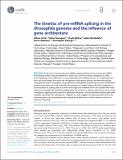The kinetics of pre-mRNA splicing in the Drosophila genome and the influence of gene architecture
Author(s)
Henriques, Telmo; McCue, Kayla; Burkholder, Adam; Adelman, Karen; Pai, Athma A.; Burge, Christopher B; ... Show more Show less
Downloadelife-32537-v2.pdf (2.745Mb)
PUBLISHER_CC
Publisher with Creative Commons License
Creative Commons Attribution
Terms of use
Metadata
Show full item recordAbstract
Production of most eukaryotic mRNAs requires splicing of introns from pre-mRNA. The splicing reaction requires definition of splice sites, which are initially recognized in either intron-spanning (‘intron definition’) or exon-spanning (‘exon definition’) pairs. To understand how exon and intron length and splice site recognition mode impact splicing, we measured splicing rates genome-wide in Drosophila, using metabolic labeling/RNA sequencing and new mathematical models to estimate rates. We found that the modal intron length range of 60–70 nt represents a local maximum of splicing rates, but that much longer exon-defined introns are spliced even faster and more accurately. We observed unexpectedly low variation in splicing rates across introns in the same gene, suggesting the presence of gene-level influences, and we identified multiple gene level variables associated with splicing rate. Together our data suggest that developmental and stress response genes may have preferentially evolved exon definition in order to enhance the rate or accuracy of splicing.
Date issued
2017-12Department
Massachusetts Institute of Technology. Department of Biological Engineering; Massachusetts Institute of Technology. Department of BiologyJournal
eLife
Publisher
eLife Sciences Publications, Ltd
Citation
Pai, Athma A, et al. “The Kinetics of Pre-mRNA Splicing in the Drosophila Genome and the Influence of Gene Architecture.” eLife 6 (December 2017): e32537 © 2017 eLife Sciences Publications Ltd
Version: Final published version
ISSN
2050-084X